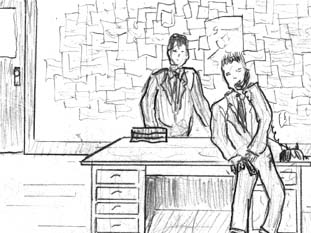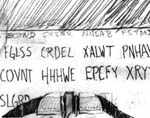 |
"Treasure Island" breaks a lot of rules. It is a film set during World War II whose protagonists - would-be desk jockey heroes - are miles away from the characters on board Cary Grant's submarine in "Destination Tokyo." It is a film in which the true identity of its characters - and perhaps even of a nation at war - is constantly obscured behind a code of lies and a deliberate patina of the war effort, a code which a traditional narrative structure could not have accommodated. And it is a film that was created quite literally not by a single director, but by six of them. Scott King is credited with writing Treasure Island (which he did); with directing Treasure Island (which he did); and with photographing Treasure Island (which he did). But he had a lot of help. When looking to hire crew members, the film's producer, Adrienne Gruben, almost coincidentally ended up seeing a lot of people with expertise in certain areas of production who had also directed their own films. Script supervisor Robert Byington is the director of Shameless (1995) as well as Olympia, which opened the 1998 South by Southwest Festival in Austin and closed the 1998 Slamdance Film Festival. Gaffer Philip Glau is the director of Circus Redickuless, a feature documentary about a punk rock circus which has also toured the festival route. On-set sound mixer Dante Harper directed The Delicate Art of the Rifle, which was honored with Best Film at Chicago's Underground Film Festival. And first assistant director Abe Levy is the director of a film called 13, while camera operator Jonathan Sanford's first film, The Big Charade played a number of festivals, including South by Southwest. And As producer Gruben told Indie-wire, the on-line news daily of the independent film community, shortly after principal photography on Treasure Island was completed: "I've noticed on films with first time directors that the crew sits around saying, 'If I were making a movie, I'd do it this way.' And...with a first time director...I didn't want the crew against the director; I wanted some padding, so they'd all have some empathy for Scott in this situation... I hired people who I thought had matching personalities. I hired a bunch of diplomats, basically, who had training in certain departments." "Shockingly," King told Indie-wire at the same time, "everyone helped a great deal...It was crucial. I know everyone (may think) that I just shot the movie that I wanted to shoot, but every day one of (the other people who had directed before) said something like, "This won't work, you should do it this way." Sometimes I would say 'no' and sometimes I would say 'yes.' Phil did almost all the lighting in the movie and I was the DP partially in name. As the writer, I came up with all the ideas, but Jonathan set up all the shots and Bob was the script supervisor and essentially directed the actors." |
|
To King, the creating the aesthetic of Treasure Island would be as important as the story upon which the story is hung. The film's look -- the meticulously crafted 1940's period costumes, its lighting with an emphasis on shadow, its re-creation of newsreel and episodic serial footage, its presentation in the 1:33 aspect ratio -- was designed with the goal of making contemporary viewers feel like they are watching a film that actually was made in the 1940's.
Off the set, King and his production designer, Nathan Marsak, are obsessed with the period depicted in Treasure Island -- the 1940's. As much as possible in their day-to-day lives, King and Marsak have tried to surround themselves with rotary phones and pneumatic tubes, old cars and older suits. As producer Gruben puts it, "Their preoccupation with detail and proximity to historical consciousness bears no relation to anything 'retro' -- they don't go swing dancing, they build dirigibles." While King and Marsak's knowledge of and obsession with historical accuracy of the period is certainly reflected in Treasure Island, their need for accuracy more then once stopped production as props or wardrobe of questionable vintage was discarded and replacements had to be found. Two Los Angeles based groups were brought in to consult on the look of Treasure Island. A group called the G.I. Jitterbugs and Ron Lane, a military re-enactment consultant who has worked with Steven Spielberg, were regular visitors to the set. As production designer Nathan Marsak recalls, "We were working in close quarters, and the crew was not altogether accustomed to a room full of men in uniform toting heavy weaponry. Military re-creation people live militarily with no sense of irony at all." "I want audiences to question their perception of what was true and what was not true about those times," King says. "From the perspective of history, we tend to remember the 40's as a time when all Americans were united by the war effort. In fact, the 40's were a time of great turmoil, not only in the Pacific and European theatres of war but at home as well. The U.S. experienced severe race riots, its first bout of what was then called Juvenile delinquency, massive and violent race riots and the radical shift that occurred when women overtook what were then considered male occupations. "What is also often overlooked," King concludes, "is that a few of the countries big cities, like San Francisco, were decidedly hedonistic, even by today's standards. I wanted to explore how that hedonism might have manifested itself within the strict confines of what would have been socially acceptable." |
 |
 |
Although he may be uncomfortable with the notion, it is fair to say that Scott King was bound to one day make a movie that he could call his own. For the last several years, King has very quietly established himself as Hollywood iconoclast. He has served as executive producer on a number of daring films. He was the original investor in Miguel Arteta's startling and acclaimed film Star Maps, a sensation at the 1997 Sundance Film Festival, where Fox Searchlight Pictures acquired it for distribution. (Later that year, the film was a nominee for Best Picture at the Independent Feature Project Spirit Awards). He also was executive producer of Olympia, a feature by Robert Byington which closed this year's Slamdance film festival and opened Austin's South by Southwest film festival, and Shotgun Freeway: Drives thru Lost L.A., a documentary on the history of Los Angeles featuring James Ellroy and David Hockney. That film played at Los Angeles' art palace, The NuArt, and went on to air on PBS.
In a sense, the films that King has been involved with up to and including Treasure Island have all challenged the assumptions we have about cultural stereotypes, particularly in his native California. Star Maps boldly used prostitution as a metaphors for the racism and exploitation the Hollywood entertainment industry. Shotgun Freeway revealed many of the darker facts behind the growth of Los Angeles not just as a city, but as an idea. And Olympia, which starts off as a story of a Mexican Soap Opera actress who comes illegally into the US, becomes a story of empowerment as she dedicates her life to her passion for throwing the javelin. Perhaps it is this desire to challenge assumptions and stereotypes that has led King to create a film that not only uses a number of visual techniques - shallow-focus shots, consistent backlighting and black and white stock - as well as a storyline of deception to try, in a sense, to re-write history. But by employing a number of directors to help guide him through what was a very technically demanding shoot - a shoot that could easily overwhelm any first time filmmaker - King risked and did not mind risking exploding the notion that only one person is the true author of any one film. Again, from Indie-wire: "Is the director nothing?" King asks. "What's the difference between being a first time director and a tenth time director? I mean you are thrown into a situation and all you do is make stuff up. Either you make up stuff well or you make up stuff poorly." Today, King would tell any first-time filmmaker that the only way that they will ever make a halfway decent film is to surround themselves with talented people who really know what they are doing. "As a self-confessed control freak, I was amazed at how people who believed in the project were able to rise to the occasion to the degree that I did not hate them for doing so. It took a number of days into production for me to become completely comfortable with everyone doing jobs that were theirs to do, not mine." King has since realized that the actual production phase of Treasure Island was anti-climactic for him because it was the process of writing the story and planning the shots and casting the roles before production began that was the most exciting for him. "I could never have made Treasure Island without the help and contributions I got from Adrienne and the team she assembled," King says now. "And the dedication and enthusiasm of the actors - people I respect a lot and of whom I asked a great deal - is something I will always be grateful for. "As for post-production, the contributions of the composer, Chris Anderson, and the editor, Dody Dorn, have shaped a tricky experiment into what we think is a real movie that we are all proud of." |